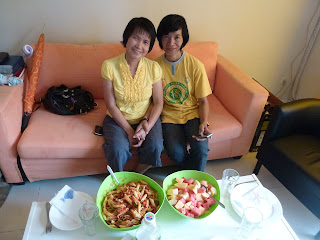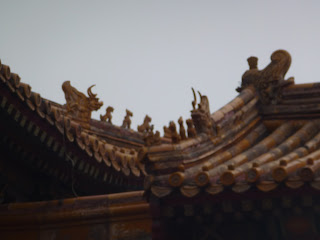Last Tuesday, I met LaDeana and Mary - two women from the branch - for a little outing. Mary has lived here a couple of years and also filled a mission in Taiwan, so she does all the talking for us. She also is the Relief Society president. She volunteered to take us to the Christian Wood Carving shop, but we decided to do lunch and a little wandering first. Behind the two women is the Qianmen Gate which is just south of Tian'anmen Square and was the main entrance into Beijing in ancient times.
We walked south through another gate to enter an area of the city that was built specifically as a tourist spot for the Olympics. It is meant to look old, but is very new. There are many nice shops and restaurants. Those of you who went to China with me last year will remember it as the street with the Haagen Dazs Ice Cream Store where an ice cream cone cost $7 and KFC.
I needed to take a picture with the little Chinese man. By the way, I usually don't wear a skirt when I go sightseeing, but I met my friends on my way home from work.
We decided we would eat at the California Noodle Shop because it was on the way to the wood carving place. The man who owns it lived California many years, and then he came back to China to start a restaurant here - thus the name California Noodle Shop. Nothing like a big bowl of noodles and eggplant. It was very tasty. And I did manage to eat it with chopsticks.
When we walked out of the noodle shop, we could see a little dirt street directly across from us. That is the street to the wood carving shop. Almost everything on it is under construction. We decided they are trying to make their little street match the main shopping area. I was very glad I wasn't trying to find this place on my own.

Could not resist taking a picture of a door. The round pieces of wood was once used to let people know the status of the family in the community. Four was the most anyone could have. So in ancient times, the people in this home would have had the highest status.
There were still many little shops and homes amidst all of the construction.
After walking about a half a mile, we came to a fork in the road, and we turned to the right and took the one less traveled by, and that made all the difference. (Maybe that is what I should call my blog - The Road Less Traveled - because it certainly has made all the difference.) A few feet more, and there was the Christian Carving Shop in front of us. After climbing some stairs to the second floor, we arrived at our destination.
The woodcarver has many different sizes of Nativity scenes. My favorite was the one below because the people are Chinese. He also does carvings of Noah and the ark, except the ark is a Chinese boat. (I am sorry, but I didn't take a picture of one to show you - maybe next time.
So imagine our surprise when we saw the next wood carving on a back street in China. Look closely, and I think you will be surprised too. When we asked the shopkeeper what it was called, she said it was "The Tree of Life." She didn't know anything else about it. Somebody did a very good job of explaining Lehi's Dream to the wood carver.
Ladeana made some purchases, and then we headed for the subway. It was a lovely afternoon, and I am sure I will make my way back to the wood carving shop again.





























































